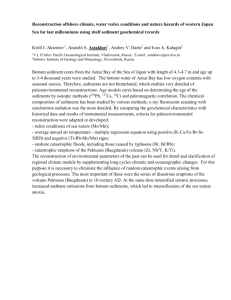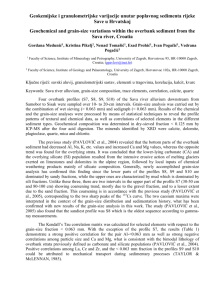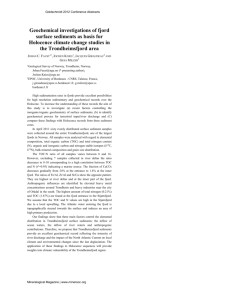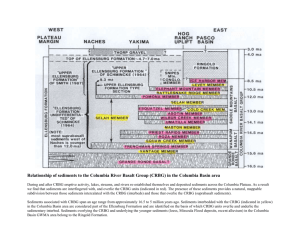Mercury in the stream and overbank sediments of the Žumberak
advertisement
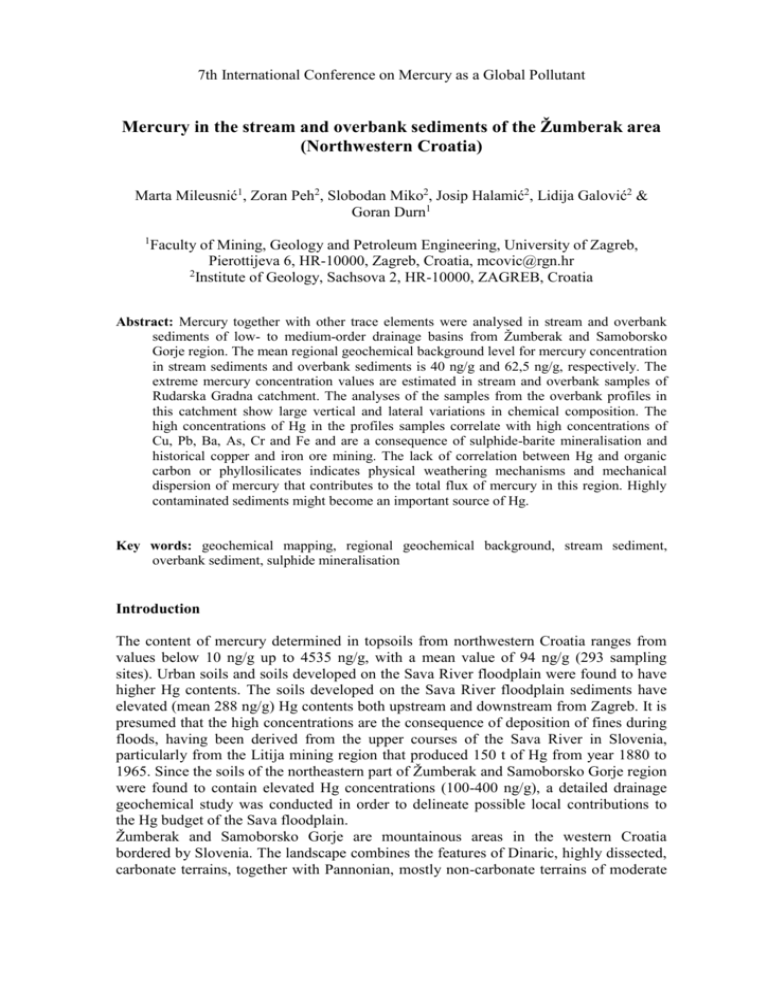
7th International Conference on Mercury as a Global Pollutant Mercury in the stream and overbank sediments of the Žumberak area (Northwestern Croatia) Marta Mileusnić1, Zoran Peh2, Slobodan Miko2, Josip Halamić2, Lidija Galović2 & Goran Durn1 1 Faculty of Mining, Geology and Petroleum Engineering, University of Zagreb, Pierottijeva 6, HR-10000, Zagreb, Croatia, mcovic@rgn.hr 2 Institute of Geology, Sachsova 2, HR-10000, ZAGREB, Croatia Abstract: Mercury together with other trace elements were analysed in stream and overbank sediments of low- to medium-order drainage basins from Žumberak and Samoborsko Gorje region. The mean regional geochemical background level for mercury concentration in stream sediments and overbank sediments is 40 ng/g and 62,5 ng/g, respectively. The extreme mercury concentration values are estimated in stream and overbank samples of Rudarska Gradna catchment. The analyses of the samples from the overbank profiles in this catchment show large vertical and lateral variations in chemical composition. The high concentrations of Hg in the profiles samples correlate with high concentrations of Cu, Pb, Ba, As, Cr and Fe and are a consequence of sulphide-barite mineralisation and historical copper and iron ore mining. The lack of correlation between Hg and organic carbon or phyllosilicates indicates physical weathering mechanisms and mechanical dispersion of mercury that contributes to the total flux of mercury in this region. Highly contaminated sediments might become an important source of Hg. Key words: geochemical mapping, regional geochemical background, stream sediment, overbank sediment, sulphide mineralisation Introduction The content of mercury determined in topsoils from northwestern Croatia ranges from values below 10 ng/g up to 4535 ng/g, with a mean value of 94 ng/g (293 sampling sites). Urban soils and soils developed on the Sava River floodplain were found to have higher Hg contents. The soils developed on the Sava River floodplain sediments have elevated (mean 288 ng/g) Hg contents both upstream and downstream from Zagreb. It is presumed that the high concentrations are the consequence of deposition of fines during floods, having been derived from the upper courses of the Sava River in Slovenia, particularly from the Litija mining region that produced 150 t of Hg from year 1880 to 1965. Since the soils of the northeastern part of Žumberak and Samoborsko Gorje region were found to contain elevated Hg concentrations (100-400 ng/g), a detailed drainage geochemical study was conducted in order to delineate possible local contributions to the Hg budget of the Sava floodplain. Žumberak and Samoborsko Gorje are mountainous areas in the western Croatia bordered by Slovenia. The landscape combines the features of Dinaric, highly dissected, carbonate terrains, together with Pannonian, mostly non-carbonate terrains of moderate 7th International Conference on Mercury as a Global Pollutant relief and with a regular drainage network. The geology of the area is presented on the sheets Zagreb (Šikić et al., 1978), Črnomelj (Bukovac et al., 1983) and Novo Mesto (Pleničar et al., 1976) of the basic geological map of Croatia. Two distinctly different lithologies, carbonate and non-carbonate sedimentary rocks, are associated in a complex way. The area is distant from industrial centres, main communications and other sources of pollution. There are, however, two known sources of human influence that may be observed in the local catchment areas: bygone mining activities, and recent agricultural activity. Small-scale siderite-haematite-sulphide ore deposit of submarine sedimentary origin in the valley of Rudarska Gradna had been mined extensively for iron for a few hundred years (Šinkovec, 1971). The main ore body is accompanied by haematite lenses as well as with sulphide veins containing chalcopyrite and a barite-galena paragenesis. Small mineral occurrences of the same origin are widely disseminated through the Permian outcrops of the nearby valleys such as Lipovačka Gradna and Ludvić. Estimation of geochemical background concentrations of toxic elements is required in order to document the present state of the surface environment and to provide the datum against which any changes can be measured (Darnley, 1990). This is especially important in pristine domains such as Žumberak, declared a protected area by the government. The drainage basin sediments (stream, overbank and floodplain sediments) contain records of natural geochemical characteristics, but also of human impact on the vulnerable environment. Variability in the trace element content, mercury included, hosted in these sediments can originate from many sources such as parent lithology, hydrology, geomorphology, vegetation, presence of the ore bodies as well as human activity. Stream sediments are still in use as the main sample medium in the geochemical reconnaissance of the mineralised or contaminated areas with developed drainage network, although their representation is often questioned, mostly due to oscillations of the fluvial processes in space (along the channel) and time (seasonal variations). On the other side, floodplain and overbank sediments that have been suspended in the form of nearly horizontal layers above the stream channel during the large floods are very representative sample material as they are of the much greater widespread origin (Ottesen, 1989). This material is highly mixed so that the composite sample may represent the entire drainage basin. Compared to the “active” stream sediment that reflects only a limited portion of the drainage area and may be burdened by recent pollution due to the modern human activity, vertical section through the overbank or floodplain reveals variations at different times in the sedimentary history of the entire catchment. Thus, it is suitable for mapping those areas where the expected contamination is low and research is aimed at detecting the effects of lithology and mineralised bedrock. Results and discussion More than forty watersheds from the Žumberak Mt. region ranging in size from 0.57 to 125.79 km2 were sampled in a close-spaced sampling design (approximately one sample per 15 square kilometres) covering the territory of 415,57 km2 (Peh & Miko, 2001). Mercury, together with a set of 36 other elements were analysed in stream and overbank sediments. Furthermore, mineralogical analysis was carried out by means of semiquatnitative X-ray diffraction. The sample sites were selected at the basin outlet, 7th International Conference on Mercury as a Global Pollutant where both, an active stream sediment and composite material taken from the bank profile were collected simultaneously. Each sample represents the area upstream and/or upslope of each sampling site, terminating at the drainage divides. The mean regional geochemical background level for mercury concentration in stream sediments and overbank sediments is 40 ng/g (range: 10-95 ng/g) and 62,5 ng/g (range: 25-499 ng/g), respectively. The extreme values, discarded from the statistical analysis, are estimated in stream sample and overbank sample of Rudarska Gradna catchment and number 910 ng/g (contamination factor Fc=17.5, Igeo=3.9-strongly contaminated) and 11650 ng/g (Fc=159; Igeo=6.7-extremely contaminated), respectively. The main mineralogical phases determined are: quartz, dolomite, calcite, phylosillicates and feldspars. Integration of bedrock geology data and overbank sediment geochemical and mineralogical data has been effectively carried out using catchment basins as the area of influence for individual sample sites. The relationships between geochemistry, mineralogy and lithology were investigated using canonical correlation analysis. The results of canonical correlation analysis indicate high and significant correlations between lithology of drainage basins and chemical and mineralogical content of composite overbank sediments. Unfortunately, mercury did not show any significant correlation with lithology or mineral content (Čović, 2003). Overbank sediments of Gradna catchment were analysed in more detail. Five overbank sediment profiles were sampled along the course of the Gradna stream (the watershed which hosts most of historical mining sites) and its tributaries to its mouth in the river Sava. The analyses of the samples from the overbank profiles show large vertical and lateral variations in chemical composition. High concentrations of Hg in samples from Rudarska Gradna profiles correlate with high concentrations of Cu, Pb, Ba, As, Cr and Fe. Mercury, as chalcophile element, often occurs in sulphide deposits. It is common in barite deposits too (Friedrich & Plüger, 1971). Therefore, high concentrations of mercury in drainage sediments of the Rudarska Gradna stream are a consequence of sulphide-barite mineralisation and historical copper and iron ore mining in the catchment. The heavy metal concentrations highly exceed the background values and decrease downstream. High concentration of Hg in the Ludvić stream (tributary of Gradna) samples, affirm the only finding of cinnabar grain almost hundred years ago (Tućan, 1919). The lack of correlation between Hg and organic carbon or phyllosilicates indicates physical weathering mechanisms and dispersion of mercury. Conclusions The drainage basin sediments (stream and overbank sediments), found in abundance in the area of Žumberak and Samoborsko gorje, contain records of natural geochemical characteristics, but also traces of human impact. Although the mercury can be detected in both sample media, overbank sediments impart higher concentrations. The anomalous Hg concentrations detected in both sample media indicate that during high torrential flows in the past this material was eroded and re-deposited, contributing to the total flux of mercury in this region. Highly contaminated sediments might become an important source of Hg. 7th International Conference on Mercury as a Global Pollutant Acknowledgements This study was funded by the Ministry of Science and Technology of the Republic of Croatia, project No. 01810106 – “The Basic Geochemical Map of Croatia”. Their support is greatly appreciated. References Bukovac, J., Poljak, M., Šušnjar, M. & Čakalo, M. (1983): Osnovna geološka karta SFRJ 1:100.000. Tumač za list Črnomelj L33-91. Geološki zavod Zagreb i Geološki zavod Ljubljana, 1983. Savezni geološki zavod. Beograd Čović, M. (2003): Geochemical and mineralogical signatures of overbank sediments, Žumberak and Samoborsko Gorje, Croatia.- Master Thesis, Faculty of Mining, Geology and Petroleum Engineering, Zagreb, 139. Darnley A.G. (1990): International geochemical mapping: a new global project. J. Geochem. Explor. 39, 1-13. Friedrich, G.H. & Plüger, W.L. (1971): Geochemical prospecting for barite and fluorite deposits.- Toronto Symposium Volume, 151-156. Ottesen, R.T., Bogen, J., Bølviken, B. & Volden, T. (1989): Overbank sediment: a representative sample medium for regional geochemical mapping.- Journal of Geochemical Exploration, 32, 257-277. Peh, Z. & Miko, S. (2001): Geochemical Comparison of Stream and Overbank Sediments: A Case Study from the Žumberak Region, Croatia.- Geologia Croatica, 54/1, 119-130. Pleničar, M. & Premru, U. (1970): Osnovna geološka karta SFRJ 1:100.000. Tumač za list Novo Mesto L33-79. Geološki zavod Ljubljana, 1970. Savezni geološki zavod. Beograd Šikić, K., Basch, O. & Šimunić, A. (1979): Osnovna geološka karta SFRJ 1:100.000. Tumač za list Zagreb L33-80. Institut za geološka istraživanja, Zagreb 1972. Savezni geološki zavod, Beograd. Šinkovec, B. (1971): Geologija ležišta željezne i bakrene rude u Rudama kraj Samobora, Geološki vjesnik, 24, 165-181. Tućan, F. (1919): Naše rudno blago, Matica hrvatska, Zagreb.
